Lyons W.C. (ed.). Standard handbook of petroleum and natural gas engineering.2001- Volume 1
Подождите немного. Документ загружается.


Drilling Muds and Completion Fluids
705
The filtercake plugging of perforations or fractures is usually difficult to
remove through acidizing or backflowing. The solutions are:
*
use of solids-free brine
*
use of bridging solids that are acid/oil soluble
*
use of commercial bridging materials (large fractures or perforations)
The compatibility of invading fluids with pay zone rocks may relate to swelling
clays, water blocking, or emulsion blocking. In many sandstone reservoirs there
are agglomerations of clay minerals and other fine formation particles are in
equilibrium with the pore fluids. If the existing brine is displaced with a lower
salinity fluid from the completion fluid, swelling clays such as montmorillonite
or some illites can expand, and non-swelling clays such as kaolinite can disperse.
The swelling and disaggregation can lead to a blocking of the pores.
In the water-blocking mechanism large volumes of invaded liquid may be
retained by low permeability or low-pressure formations. The blocking may occur
for an oil wet and a water wet sandstones.
The design factors to prevent blocking involve the use of low-viscosity fluids
with minimum interfacial tension, minimum capillary pressure, and minimal
fluid loss.
The emulsion blocking mechanism involves formation of emulsion in the pores
either by self-emulsification
of
water-based filtrate with the crude oil, or oil
filtrate from an oil-based fluid emulsifying formation water. The emulsions are
viscous and can block the pores. The remedial design is to prevent emulsification
either by eliminating oil from completion fluid or by the use of demulsifiers.
Components in the invading water-based filtrate and in the formation waters
may react to form insoluble precipitates which can block the pores and give rise
to skin damage. The scale can be formed by interaction of calcium-based brines
with carbon dioxide or sulfate ions in the formation water. Alternatively sulfate
ions in the invading fluid may react with calcium or barium ions in the
formation water. Analysis of the formation water can identify whether such a
problem may arise.
Table
4-62
contains a checklist for proper selection of completion/workover fluids.
CompletionMlorkover
Fluid
Systems
Selection of completion/workover fluid system is entirely dependent upon its
function, which, in turn, depends on the completion method. The method may
involve underreaming, gravel packing, perforation, or workover. Completion
fluids used for underreaming have to display formation bridging and low spurt
loss
and filtrate loss to support the sand and prevent sloughing. Because the
filter cake will be trapped between the gravel pack and the formation, the fluid
should be composed of particles, soluble in acid or oil, and small enough not
to
bridge off the gravel pack when the well is flowed.
Gravel packing completion fluids should exhibit sufficient viscosity
to
carry
and place the gravel efficiently. However, high gel strengths for prolonged
suspension are not necessary. Thus the polymer solution can easily flow out of
the pack
on
production. Also, the solution can be formulated with a breaker
(enzyme or oxidizer) such that the viscosity is completely broken allowing
complete cleanup. Normally, filtrate loss control is not employed in the gravel
carrying fluid.
Low-density perforating completion fluids for underbalanced perforation
greatly reduce the possibilities of plugging. If overbalance perforation is needed,
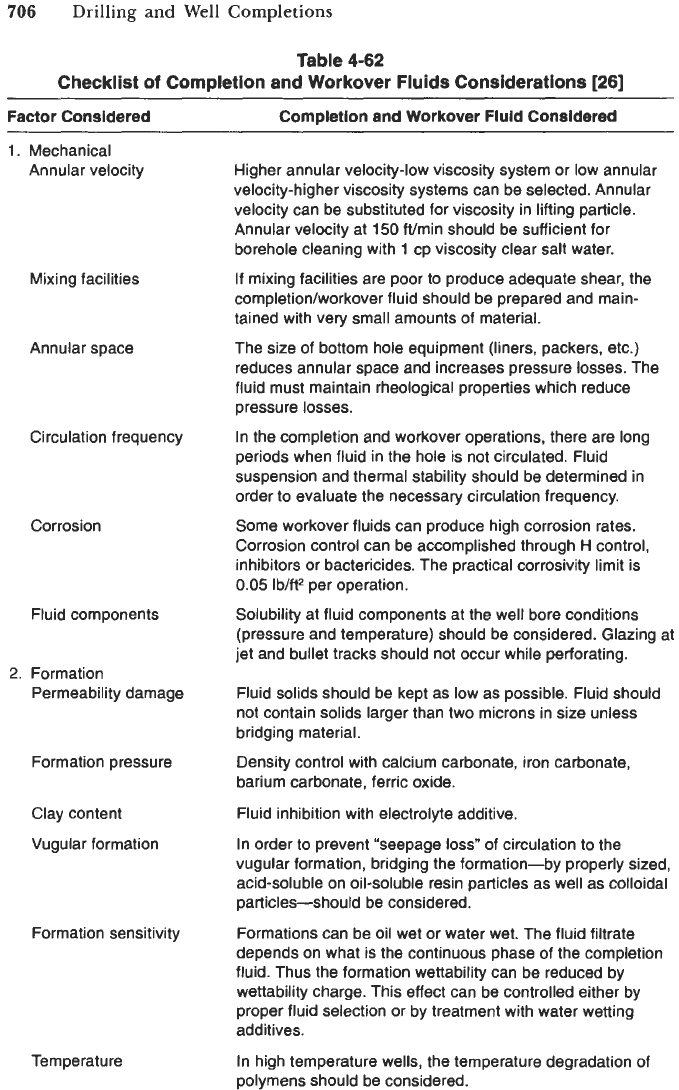
706
Drilling
and
Well Completions
Table
4-62
Checklist
of
Completion and Workover Fluids Considerations
[26]
Factor Considered Completion and Workover Fluid Considered
1.
Mechanical
Annular velocity
Higher annular velocity-low viscosity system or low annular
velocity-higher viscosity systems can be selected. Annular
velocity can be substituted for viscosity in lifting particle.
Annular velocity at
150
Wmin should be sufficient for
borehole cleaning with
1
cp viscosity clear salt water.
Mixing facilities
Annular space
Circulation frequency
Corrosion
Fluid components
2.
Formation
Permeability damage
Formation pressure
Clay content
Vugular formation
Formation sensitivity
Temperature
If
mixing facilities are poor to produce adequate shear, the
completion/workover fluid should be prepared and main-
tained with very small amounts of material.
The size of bottom hole equipment (liners, packers, etc.)
reduces annular space and increases pressure losses. The
fluid must maintain rheological properties which reduce
pressure losses.
In the completion and workover operations, there are long
periods when fluid in the hole is not circulated. Fluid
suspension and thermal stability should be determined in
order to evaluate the necessary circulation frequency.
Some workover fluids can produce high corrosion rates.
Corrosion control can be accomplished through H control,
inhibitors or bactericides. The practical corrosivity limit is
0.05
Ib/ft2 per operation.
Solubility at fluid components at the well bore conditions
(pressure and temperature) should be considered. Glazing at
jet and bullet tracks should not occur while perforating.
Fluid solids should be kept as low as possible. Fluid should
not contain solids larger than two microns in size unless
bridging material.
Density control with calcium carbonate, iron carbonate,
barium carbonate, ferric oxide.
Fluid inhibition with electrolyte additive.
In order to prevent "seepage
loss"
of circulation to the
vugular formation, bridging the formation-by properly sized,
acid-soluble on oil-soluble resin particles as well as colloidal
particles-should be considered.
Formations can be oil wet or water wet. The fluid filtrate
depends on what is the continuous phase
of
the completion
fluid. Thus the formation wettability can be reduced by
wettability charge. This effect can be controlled either by
proper fluid selection or by treatment with water wetting
additives.
In high temperature wells, the temperature degradation of
polymens should be considered.

Drilling Muds and Completion Fluids
707
Factor
Considered
Completion and
Workover
Fluid Considered
3.
Fluid properties
Density
Ideal requirements: Fluid density should not be greater than
that which balances formation pressure.
Practical recommendation: Differential pressure should not
exceed
100-200
psi.
Solids content
Fluid
loss
Rheology
Ideal requirements: no solids in completion and workover
fluids.
Practical recommendation: Solids smaller than two microns
can be tolerated as well
as
the bridging solids. The bridging
solids should
be:
(1)
greater than one-half
of
the average
fracture diameter:
(2)
readily flushed from the hole; acid or
solvent soluble.
Ideal requirements: no fluid
loss.
Practical recommendations: Fluid
loss
to the formation can
be controlled by:
(1)
fluid-loss agents or vixcositiers such as
polymens, calcium carbonate, gilsonit, asphalt etc.,
(2)
bridg-
ing materials.
Ideal requirements: low viscosity with the yield point and gels
necessary for hole cleaning and solids suspension.
Practical recommendation:
A
compromise should be found to
minimize pressure losses and bring sand or cutting to the
surface at reasonable circulating rate.
Courtesy Baroid Drilling Fluids. Inc.
low damaging fluids are recommended and often a solids-free fluid is preferred.
This is because filter cake from a high solids fluid can completely fill a
perforation and be difficult to remove on back flowing or acidizing.
Perforating under diesel is sometimes employed. In this case, care is necessary
to ensure that good displacement of the previous denser fluid occurs, and the
completed zone remains in contact with the diesel without density swapping.
Perforating fluids used may be filtered clear brine or CaCO, type completion
fluids, oil, seawater, acetic acid, gas or mud.
Where large losses to the formation are probable, perforation under slugs
containing degradable bridging and loss control materials is advised. At least,
such materials should be on hand should the need arise. Under these conditions,
it is far better to fill perforations with good, degradable, bridging material than
the common mixture
of
iron and rust particles, mud solids, and excess pipe
dope. These foreign solids may be also not exhibit bridging and be injected into
the rock around the perforations, causing irreparable damage.
Clear
Brines.
Brine solutions are made from formation saltwater, seawater, or
bay water, as well as from prepared saltwater. They do not contain viscosifers
or weighting materials. Formation water-base fluids should be treated for
emulsion formation and for wettability problems. They should be checked on
location to ensure that they do not form
a
stable emulsion with the reservoir
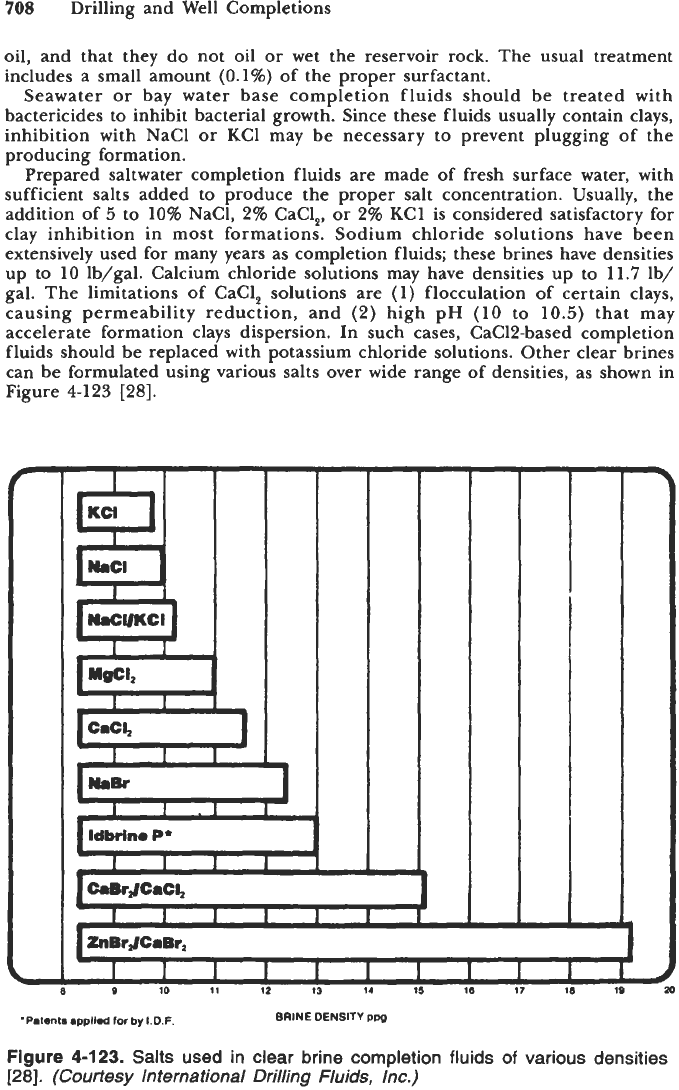
708
Drilling
and
Well Completions
oil, and that they do not oil or wet the reservoir rock. The usual treatment
includes a small amount (0.1%) of the proper surfactant.
Seawater or bay water base completion fluids should be treated with
bactericides to inhibit bacterial growth. Since these fluids usually contain clays,
inhibition with NaCl or KCl may be necessary to prevent plugging of the
producing formation.
Prepared saltwater completion fluids are made of fresh surface water, with
sufficient salts added to produce the proper salt concentration. Usually, the
addition of
5
to
10%
NaCl,
2%
CaCl,, or 2% KCl is considered satisfactory for
clay inhibition in most formations. Sodium chloride solutions have been
extensively used for many years as completion fluids; these brines have densities
up
to
10
lb/gal. Calcium chloride solutions may have densities up to
11.7
lb/
gal. The limitations of CaCl, solutions are
(1)
flocculation of certain clays,
causing permeability reduction, and (2) high
pH
(10 to 10.5) that may
accelerate formation clays dispersion. In such cases, CaCl2-based completion
fluids should be replaced with potassium chloride solutions. Other clear brines
can be formulated using various salts over wide range of densities, as shown in
Figure
4-123
[28].
I
I
.I
I
!
Idbrine
P*
I
I
1
I
1
I
I
.I
I
!
Idbrine
P*
I
I
1
I
1
*Patents
applied
for by
I.D.F.
BRINE
DENSITY
PW
Figure
4-123.
Salts
used in clear brine completion fluids
of
various densities
[28].
(Courtesy International Drilling Fluids, Inc.)
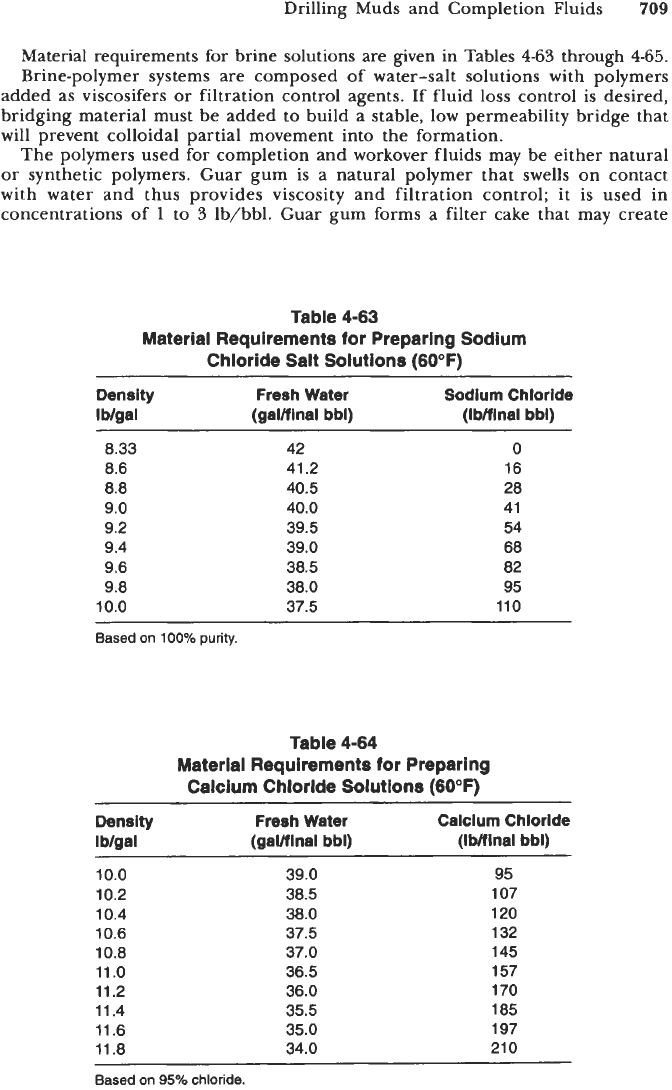
Drilling Muds and Completion Fluids
709
Material requirements
for
brine solutions are given in Tables
4-63
through
4-65.
Brine-polymer systems are composed of water-salt solutions with polymers
added as viscosifers
or
filtration control agents. If fluid loss control is desired,
bridging material must be added to build a stable, low permeability bridge that
will prevent colloidal partial movement into the formation.
The polymers used for completion and workover fluids may be either natural
or synthetic polymers. Guar gum is a natural polymer that swells
on
contact
with water and thus provides viscosity and filtration control; it is used in
concentrations of
1
to
3
Ib/bbl. Guar gum forms a filter cake that may create
Table 4-63
Material Requirements for Preparing Sodium
Chloride Salt Solutions (60°F)
Density
Fresh Water Sodium Chloride
Iblgal (gallfinal bbl) (Iblflnal bbl)
~~ ~ ~ ~ ~~ ~
8.33 42
0
8.6 41.2 16
8.8 40.5 28
9.0
40.0
41
9.2 39.5 54
9.4 39.0 68
9.6 38.5 82
9.8 38.0 95
10.0 37.5 110
Based
on
100%
purity.
Table 4-64
Material Requirements
for
Preparing
Calcium Chloride Solutions
(60°F)
Density
Fresh Water Calcium Chloride
Iblgal (gaMInal bbl) (IWtlnal bbl)
10.0 39.0 95
10.2 38.5 107
10.4 38.0 120
10.6 37.5 132
10.8 37.0 145
11.0 36.5 157
11.2 36.0 170
11.4 35.5 185
11.6 35.0 197
11.8 34.0 210
Based
on
95%
chloride.
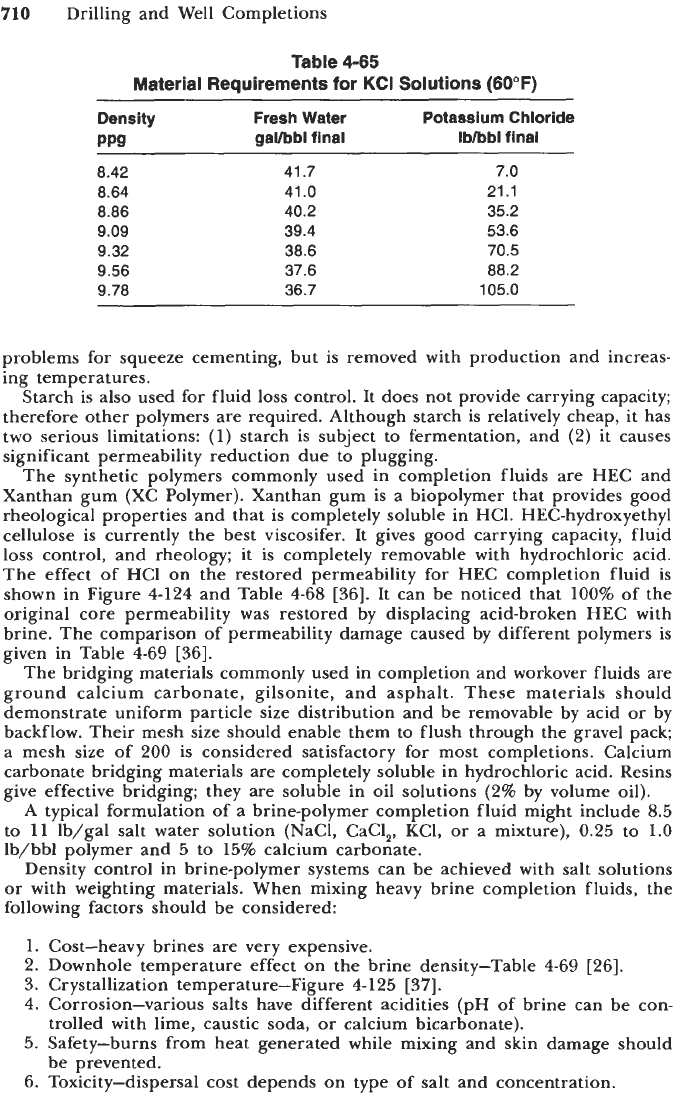
710
Drilling
and
Well Completions
Table
4-65
Material Requirements for
KCI
Solutions
(60°F)
Density Fresh Water Potassium Chloride
PDSI
galhbl final lblbbl final
8.42 41.7 7.0
8.64 41
.O
21.1
8.86 40.2 35.2
9.09 39.4 53.6
9.32 38.6 70.5
9.56 37.6 88.2
9.78 36.7 105.0
problems for squeeze cementing, but is removed with production and increas-
ing temperatures.
Starch is also used for fluid loss control. It does not provide carrying capacity;
therefore other polymers are required. Although starch is relatively cheap,
it
has
two serious limitations:
(1)
starch is subject to fermentation, and
(2)
it
causes
significant permeability reduction due to plugging.
The synthetic polymers commonly used in completion fluids are HEC and
Xanthan gum (XC Polymer). Xanthan gum is a biopolymer that provides good
rheological properties and that is completely soluble in HCl. HEC-hydroxyethyl
cellulose is currently the best viscosifer. It gives good carrying capacity, fluid
loss control, and rheology; it is completely removable with hydrochloric acid.
The effect of HCl on the restored permeability for HEC completion fluid is
shown in Figure
4-124
and Table
4-68
[36].
It can be noticed that
100%
of the
original core permeability was restored by displacing acid-broken HEC with
brine. The comparison of permeability damage caused by different polymers is
given in Table
4-69
[36].
The bridging materials commonly used
in
completion and workover fluids are
ground calcium carbonate, gilsonite, and asphalt. These materials should
demonstrate uniform particle size distribution and be removable by acid or by
backflow. Their mesh size should enable them to flush through the gravel pack;
a mesh size of
200
is considered satisfactory for most completions. Calcium
carbonate bridging materials are completely soluble in hydrochloric acid. Resins
give
effective bridging; they are soluble in oil solutions
(2%
by volume oil).
A
typical formulation
of
a brine-polymer completion f hid might include
8.5
to
11
lb/gal salt water solution (NaCl, CaCl,, KCl,
or
a mixture),
0.25
to
1.0
lb/bbl polymer and
5
to
15%
calcium carbonate.
Density control in brine-polymer systems can be achieved with salt solutions
or with weighting materials. When mixing heavy brine completion fluids, the
following factors should be considered:
1.
Cost-heavy brines are very expensive.
2.
Downhole temperature effect on the brine density-Table
4-69
[26].
3.
Crystallization temperature-Figure
4-125
[37].
4.
Corrosion-various salts have different acidities (pH of brine can be con-
5.
Safety-burns from heat generated while mixing and skin damage should
6.
Toxicity-dispersal cost depends on type of salt and concentration.
trolled with lime, caustic soda, or calcium bicarbonate).
be prevented.
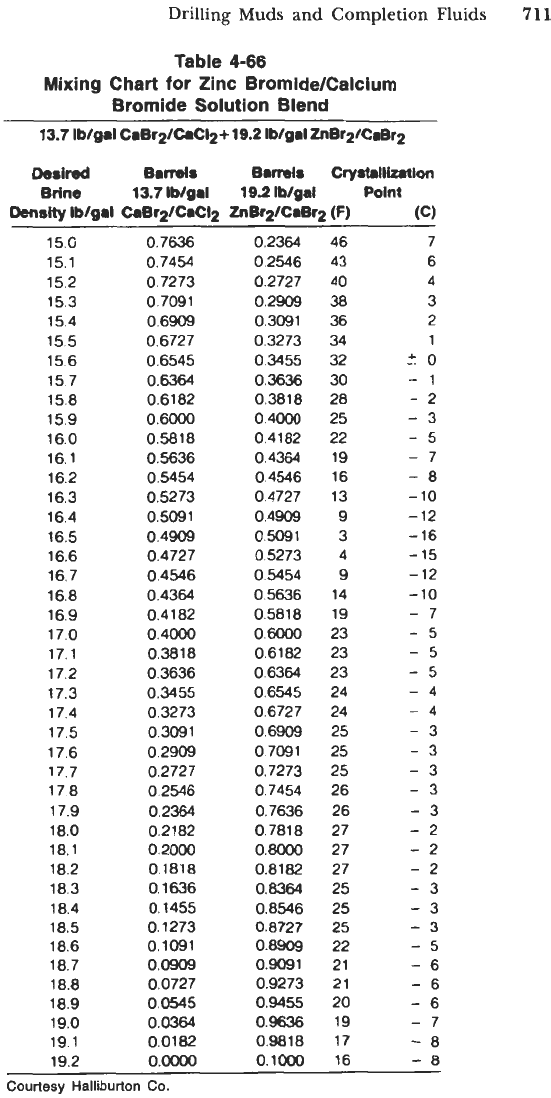
Drilling
Muds
and
Completion Fluids
711
Table
4-66
Mixing
Chart for Zinc Bromide/Calcium
Bromide
Solution
Blend
13.7
Iblgal
CaBr2/C.C12+ 19.2
Iblgal
ZnBr2ICaBr2
h8hd
Barrels
Bamls
Cry.1.lliZrtlon
(C)
Brine
13.7
IWgal
19.2
IWgd
Point
Density
Ib/gal
CnBr2/CaC12 ZnBr2/CaBr2
(F)
15.0
15.1
15.2
15.3
15.4
15.5
15.6
15 7
15.8
15.9
16.0
16.1
16.2
16.3
16.4
16.5
16.6
16.7
16.8
16.9
17.0
17.1
17.2
17.3
17.4
17.5
17.6
17.7
17
8
17.9
18.0
18.1
18.2
18.3
18.4
18.5
18.6
18.7
18.8
18.9
19.0
19.1
19.2
0.7636
0.7454
0.7273
0.7091
0.6909
0.6727
0.6545
0.6364
0.6182
0.6000
0.5818
0.5636
0.5454
0.5273
0.5091
0.4909
0.4727
0.4546
0.4364
0.4182
0.4000
0.3818
0.3636
0.3455
0.3273
0.3091
0.2909
0.2727
0.2546
0.2364
0.2182
0.2000
0,1818
0.1636
0.1455
0.1273
0.1091
0.0909
0.0727
0.0545
0.0364
0.0182
O.oo00
0.2364
46
0.2546 43
0.2727
40
0.2909 38
0.3091 36
0.3273 34
0.3455 32
0.3636 30
0.4000
25
0.4182 22
0.4364 19
0.4546
16
0.4727 13
0.4909 9
0.5091
3
0.5273
4
0.5454
9
0.5636 14
0.5818
19
0.6OOO
23
0.6182 23
0.6364 23
0.6545 24
0.6727 24
0.6909 25
0.7091 25
0.7273 25
0.7454 26
0.7636 26
0.7018 27
0.8oOo
27
0.0182 27
0.8364
25
0.8546 25
0.0727 25
0.8909
22
0.9091
21
0.9273 21
0.9455
20
0.9636
19
0.9818
17
0.1oOO
16
0.3818 28
7
6
4
3
2
1
LO
-1
-2
-3
-5
-7
-8
-10
-12
-16
-
15
-
12
-10
-7
-5
-5
-5
-4
-4
-3
-3
-3
-3
-3
-2
-2
-2
-3
-3
-3
-5
-6
-6
-6
-7
-8
-8
Courtesy
Halliburton
Co.

712
Drilling
and
Well Completions
Table
4-67
Mixing Chart for Heavy Brines Using
Calcium Bromide and Calcium Chloride
Brines and Calcium Chloride Pellets
Brim
Barfel.
I)rml.
WldM
CryNlliU(ion
Dmlnd
~BtzBrim
38%C.C12Bdn
MM.
(0
(C)
11 8 0507 9429 606
52
__
11 1
12
0
1016 8857 1213
54
12 2
12 1 1269 8572 1515 55 12 7
Pound.
D.n.Q
14.22lblgrl
11.6lb/@d
Chlorld.
pokrt
11
7 0254 9714 286
50
10
11
9 0762 9143 909
53
11
6
12 2
1524
8286
1818 56 133
12 3 1778
eo00
2122 565 136
124
2032
7715
2424
57
-
13
8
2728 575 14
1
12 5 2286 7429
12
6
2540 7143 3031
58
14 4
12 7 2794 6857 3334585 147
12
8
3048
6572 3637 59 15
0
12 9 3302 6286 3941 595 152
13
0
3556
6Ooo
4244
60
15 5
13 1 3810 5714 4547
6a
15 5
13 2 4064 5429 4849 605 158
13 3 4318 5143 51
53
61 16 1
13 4 4572 4857
5456
61 16
1
13 5 4826 4572 5759 61
5
163
6062
615 163
13 6 5080 4286
13 7 5334 4000
6366
615 163
13
8
5589 3714 6669 615
2
13 9 5842 3429 6972 61
5
163
14
0
6069 3143 7275 62 16 6
14 1 635 1 2857 7578 62 16 6
14
2
6604
2572 7881 62 16
6
14 3
6858
2286 81
04
62
16 6
14 4 71 13 2000 8488 625 169
14
5
7366 1715 8790
63
17
0
14 6 7620 1429
9094
635 175
14 7 7875 1143 9397
64
17 7
14
8
8128
0858
9699
65
18
3
-
14 9 8382 0572 10003
66
18
8
15
0
8637 0286 10306 67 19
4
15 1 8891
oooo
10610
68
200
Courtesy
Halltburton
Co
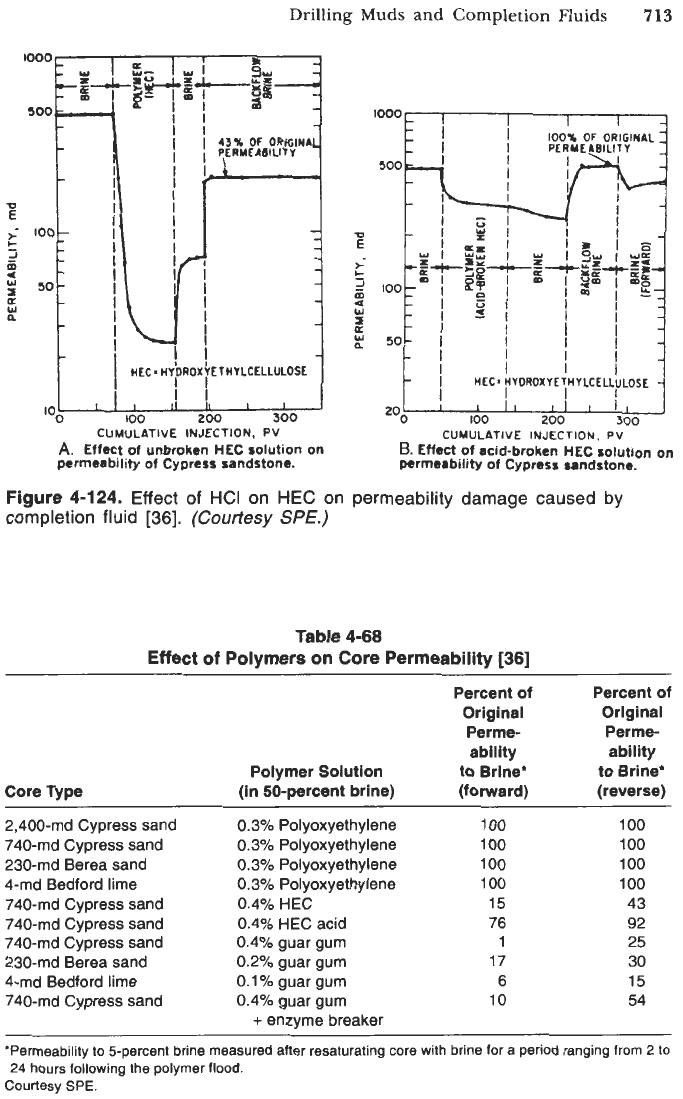
Drilling Muds and Completion Fluids
713
50-
D
E
c
J
m
a
>
4
W
I
W
fI
I
I
i,
~
-
I
=I
-
-I
-I
-
I
I
I
I
I
I
I
I
i
-
I
I
I
I
-
-
HEC. HYDROXYETHYLCELLULOSE
-
Figure 4-124.
Effect
of
HCI on HEC on permeability damage caused by
completion fluid
[36].
(Courtesy
SPE.)
Table 4-68
Effect
of
Polymers
on
Core Permeability [36]
Percent
of
Percent of
Original Original
Perme- Perme-
ability ability
Polymer Solution to Brine' to Brine*
Core Type (in 50-percent brine) (forward) (reverse)
2,400-md Cypress sand
0.3% Polyoxyethylene
100
100
740-md Cypress sand
0.3% Polyoxyethylene 100 100
230-md Berea sand
0.3%
Polyoxyethylene 100 100
4-md Bedford lime
0.3% Polyoxyethylene
1
00
100
740-md Cypress sand 0.4% HEC
15 43
740-md Cypress sand
0.4% HEC acid 76 92
740-md Cypress sand 0.4% guar gum
1 25
230-md Berea sand 0.2% guar gum
17 30
4-md Bedford lime 0.1% guar gum
6 15
740-md Cypress sand 0.4% guar gum
10
54
+
enzyme breaker
'Permeability to 5-percent brine measured after resaturating core with brine for
a
period ranging from
2
to
Courtesy
SPE.
24
hours following the polymer flood.
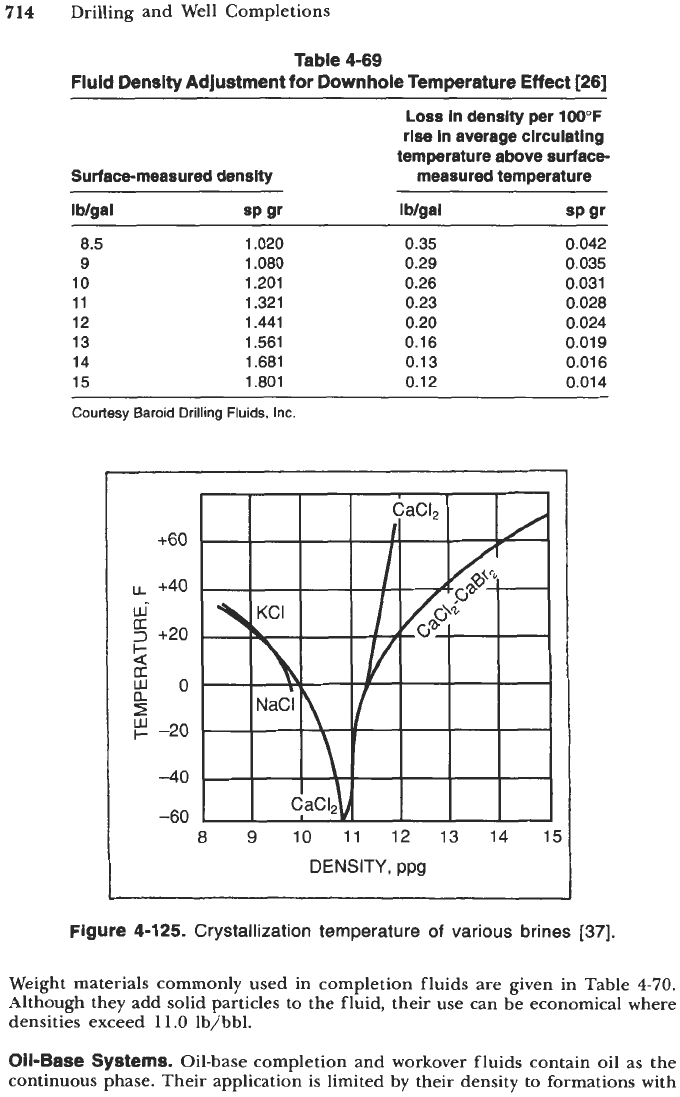
714
Drilling and Well Completions
Table 4-69
Fluid Density Adjustment for Downhole Temperature Effect [26]
Loss
in density per
100°F
rise in average circulating
temperature above surface-
Surfacemeasured density measured temperature
Iblgal
SP
gr iblgai SP gr
~ ~ ~ ~ ~ ~
8.5 1.020
0.35 0.042
9
1.080
0.29 0.035
10
1.201 0.26 0.031
11 1.321
0.23 0.028
12 1.441
0.20 0.024
13 1.561
0.16 0.019
14
1.681 0.13 0.016
15 1.801 0.12 0.014
Courtesy
Baroid Drilling Fluids,
Inc.
+60
+40
u"
5
+20
G
p
-20
CI:
wo
a
2
-40
-60
8
9
10
11
12
13 14 l!
DENSITY,
ppg
Figure 4-125.
Crystallization temperature
of
various brines
[37].
Weight materials commonly used in completion fluids are given in Table
4-70.
Although they add solid particles
to
the fluid, their use can be economical where
densities exceed
11
.O
lb/bbl.
Oil-Base Systems.
Oil-base completion and workover fluids contain oil as the
continuous phase. Their application is limited by their density to formations with
